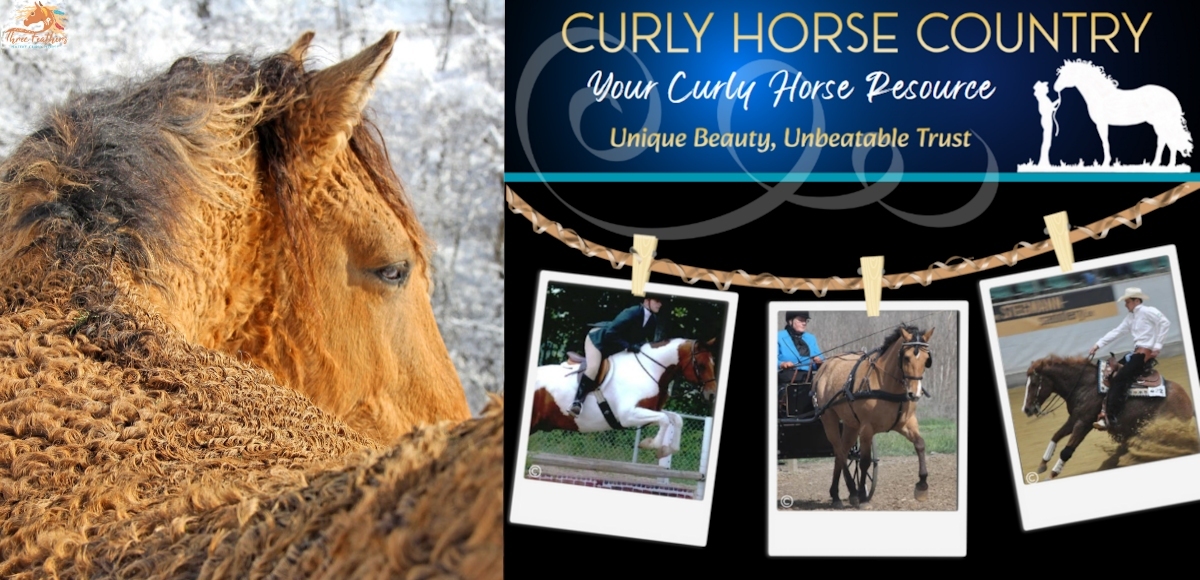Feeding & Caring for your Curly Horse
I believe one of the most important things a horse owner must learn is to develop a good eye for the body condition & health of their Curly horse(s). Even the most well intentioned horse owner can overlook obvious signs of malnourishment and/or obesity. I know because I have experienced this myself. I have had to work hard to learn & educate myself on what proper condition "looks like" and make it a priority to constantly evaluate and assess my horses to be sure I am doing everything within my power to make them happy, healthy and comfortable. I hope this article will help new curly horse owners as well as those like me that need more education. If you are considering buying a horse, be sure to evaluate the cost of ownership before buying. Michelle Ives sent in a great summary of costs. click here.
Throughout the year we have many factors that can make feeding our curly horses properly very challenging. ie. weather conditions, shelter, how much they are ridden, age and if you have breeding stock, that throws in another entirely different range of elements to consider. For this reason, we must never get stuck into thinking you can set a diet plan in place and always feed your horses the same way all year long. So, where do we start? Let's start by learning to identify if our curly horse(s) is of good weight. We need to do this by first understanding what to look for and learning to "read our horse's body." Below is a photo pointing out the primary areas.

Body Scoring
 |
Body condition scoring involves the palpation and visual assessment of the degrees of fatness of various areas of the horse, such as: over the ribs, tailhead area, neck and withers, and behind the shoulders. (See Figure 1.) Fat reserves in these areas depend on the balance between energy intake and energy loss, for various activities.
Diagram of Areas Emphasized in Condition Score (Adapted from Henneke et.al. 1981, Texas A&M) |
Assess your Curly Horse's Condition
Next, we must assess our curly horse(s) and determine where they are condition-wise on the chart below. A very thin horse or very fat horse are equally unhealthy and can cause serious health risks to your curly horse. So our goal is to maintain the look of #3.
(There are many other scoring charts online which may use a larger chart (0-9)in which case your numbers may be different, but the basic idea is to learn to identify the look of a healthy horse. I used this chart because I felt it was very simple and easy to understand for new horse owners)
NOTE: During the winter, winter coat/curls can really hide condition. They can lose quite a bit of weight before you'll even notice with those thick, puffy curls. Sometime a horse that has TOO MUCH coat, is super thick or super long, more than usual, maybe losing weight, or have poor nutrition, and is adding more hair in an attempt to keep warm. Also they may not shed as well as they should in spring. It is important to be HANDS ON with your horse during the winter, run your hands along their withers and make sure that the fat amount stays the same over the withers, along either side of the spine, and over the ribs. ~Michelle Ives, Chestnut Hill, CT
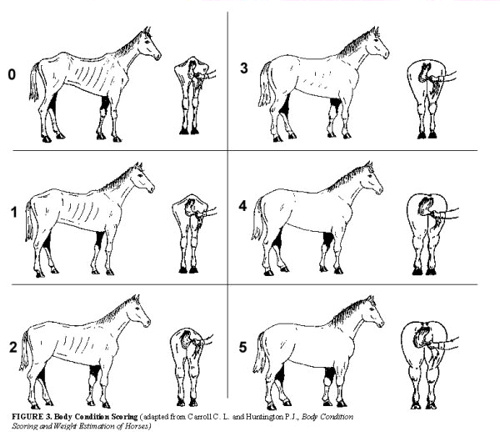
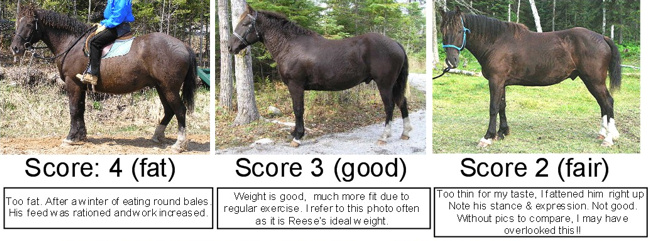
Condition |
Neck |
Withers |
Back & Loin |
Ribs |
Hind Quarters |
| 0 Very thin |
bone structure easily felt- no muscle shelf where neck meets shoulder |
bone structure easily felt |
3 points of vertebrae easily felt (see Figure 2) |
each rib can be easily felt |
tailhead and hip bones projecting |
| 1 Thin |
can feel bone structure- slight shelf where neck meets shoulder |
can feel bone structure |
spinous process can be easily felt
- transverse processes have slight fat covering |
slight fat covering, but can still be felt |
can feel hip bones |
| 2 Fair |
fat covering over bone structure |
fat deposits over withers |
dependent on conformation |
fat over spinous processes can't see ribs, but ribs can still be felt |
hip bones covered with fat |
| 3 Good |
neck flows smoothly into shoulder |
neck rounds out withers |
back is level |
layer of fat over ribs |
can't feel hip bones |
| 4 Fat |
fat deposited along neck |
fat padded around withers |
positive crease along back |
fat spongy over and between ribs |
can't feel hip bones |
| 5 Very fat |
bulging fat |
bulging fat |
deep positive crease |
pockets of fat |
pockets of fat |
Weighing your Curly Horse
 |
Third, is to weigh your curly horse. You will need to know this in order to know how much to feed and also to administer dewormers and nutritional suppliments. Be sure to always keep a chart or notes of your horse's yearly routine care, weight and condition. Buy a Weight Tape here, just $2.95
Click here for more details on weighing your curly horse.
*Note: Weight is only part of the equation. Remember that your horse can be in good weight and have a dull coat & dull eyes and listless or restless attitude which means he/she is not getting the quality of nutrition he/she needs. Consult your vet for further recommendations.
Photo courtesy of: http://www.effem-equine.com |

Preparing a feeding program for your Curly Horse
So now you understand a little about what you need to look for in a good healthy looking curly horse, you have assessed your own horse(s) and you have weighed them. Now you need to prepare a feeding program for your horse. Many factors come into play as mentioned at the start of this article, so take care to consider those factors into your program. (weather, age of horse, training etc.) Also remember, If your curly horse falls below or above #3 on the chart you will need to either increase or decrease feedings to get your horse into the desired condition range. Some suggestions are listed below.
It is a good idea to have a vet exam while developing your feeding program to be sure your horse is not experiencing any health problems along with her poor condition. (thin or obese).
Many factors could be the problem, like:
Ulcers
Deworming for parasites
Dental issues
Feeding Basics:
Water, LOOSE trace mineral salt, white salt block and good quality forage are the foundations of good nutrition for the average mature horse. When fed ad-lib (all they want), can meet the maintenance needs of most horses. When adequate levels of forage are not enough to maintain good condition, concentrates and supplements are added and adjusted to maintain good body condition. Click here to see a simple grain recipe for your curly horse.
Top Quality Hay:
A good timothy/grass hay is an excellent forage for curly horses. I personally don't feed my curlies alfalfa due to it's rich content, but if you do, make sure it is a first cutting and a blend of other grasses. To feel satisfied horses need to consume approximately 2% to 3% of the horse's body weight in dry matter a day. This is where weighing your curly horse is important. If your healthy horse weighs 1,200 lbs, you would feed between 25 lbs and 36 lbs of hay per day. You can use a bathroom scale to weigh the size of your square bale by first weighing yourself, then picking up the bale and weighing both you and the bale. Every bale is different, so weighing til you get a feel for how much, is very important. You can also buy hay scales and mount them to your barn ceiling too, which I did to start. Though horses can consume this amount of hay in about 6 hours, to feel really at ease, mature horses need to graze feed around 16 hours a day. **This means dividing your hay portions up into 3-4 feedings per day is highly recommended. I personally feed my horses at 6:00 a.m, Noon, 4:00 and then 10:00p.m. Free access to pasture is the easiest way to meet these needs but often hay is required to make up for limited pasture.
**IMPORTANT - WINTER FEEDING** In the wintertime, horses require a signficant increase in hay in order to maintain body heat. Hay is the main source of generating heat within their body when they need it. 3% of your curly horse's weight is merely a guideline and may need to be increased when weather is extreme. The hardest weather for curlies is the cold driving rain, with high winds because this matts down their hair and doesn't allow them to insulate themselves as well. Curlies should be sheltered and fed free choice hay during these times. Additionally, temps that fall below 15 degrees F, hay portions must be increased to be sure your horse is warm and happy, this can not be stressed enough. If shelter is available a few extra flakes at nite is helpful. If shelter is not, they should be given hay free choice. Learn to recognize when your horses is shivering. You will usually see quivering on the shoulder muscle or flank hip area. Watch closely, many horse owners miss seeing this critical sign to their horse's discomfort.
Q: What weather conditions are hardest on horses? (Equus Magazine)
A: Cold wind causes horses the greatest discomfort and more rapidly saps their energy because it whips away body heat faster than any other condition. Cold rain is a close second, chilling the skin through conduction and flattening of the hairs' insulating loft. "In Washington we get a lot of rain, and it can be below freezing for two to three months, though seldom below zero," says Foss. "But I think that 35 degrees and rain is much harder to deal with than lower temperatures."
Still air, frigid temperatures and snowfall are not particularly chilling to horses already adapted to colder regions. Snow accumulates atop their long winter coats without penetrating to the skin or drawing away body heat. In fact, that layer of snow serves as a sort of insulated blanket over the haircoat.
In extreme or severe weather conditions, shelter--stabling, sheds, windbreaks or other forms of natural cover--are better protection from the elements than a single garment.
Cold horse symptoms: If they are really grumpy by the next feeding, is an indicator they did not have enough. Also standing with head lowered and tail tucked/clamped is a sign before they start shivering. |
| SUMMER FEEDING: In the summer, most non-working horses do fine on 2% of their body weight in hay, with fresh water and trace minerals free choice. My horses have a tiny bit of pasture but I still suppliment with hay daily, feeding 2 to 3 small portions per day. Paying close attention to your hay being high quality and that your curly horse is dewormed regularly. If ridden moderately, you may want to add 2 cups of grain to help maintain the energy needed as well as suppliment requirements to a working horse. Every horse is different, so again it is important that you monitor your horse and adjust feed to meet proper requirements for conditioning. I add a sel/e suppliment (either megasel or selenium crumbles) to my horse's grain almost year around because we live in a deficient area. Consult your vet on selenium levels in your area's soil. |
Pasture:
With good pasture there is no weighing or dispensing, horses are just allowed to graze and you monitor their condition to decide if adjustments need to be made. They require about 6 hours a day to consume adequate amounts of forage but when left out all the time will adjust their rate of consumption to a rate of about 2 to 3% dry matter a day. On healthy growing pasture adult horses require about 2 to 3 acres to provide nutrition throughout the growing season however pasture rotation will greatly improve the productivity of a pasture. Managing and caring for pasture is of paramount importance to maintaining it as a productive resource for the horses.
Loose Minerals & White Salt Block:
It is important to provide an equine loose trace mineral to your horses, free choice. Unless they are like mine and they over consume it, in which case, I add 1-2 oz into their 2 cups of grain per day. I choose to find horse minerals without added molasses to eliminate the desire for my horses to eat it just because it takes good. Purina 12-12 minerals are good if your horses are on pasture but there are other brands out there too. Check with your vet for suggestions in your area. The trace mineral blocks are discouraged because a horse's tongue is not equipped to lick them well enough to get enough of their daily requirement per day. That is why you may see some horses actually bite them. In the case of the white salt block, they don't need as much and a few licks per day is sufficient.
Grains:
As mentioned above, I have developed a simple grain recipe that works very well with my curly horses which I recommend highly. There is no corn or molasses, which some curlies can be quite sensitive to due to their feral beginnings. I feed anywhere from 2-4 cups per day depending on time of year and work load.
Keeping Accurate Records
It is vital that you keep accurate records of your horse's condition. Document weight, feeding program, deworming schedule, vaccination schedule, farrier trims and any other considerations throughout the year. (consult your local vet for deworming & vaccinations recommendations for your area) I personally find taking photos of my horses periodically (every 3-4 months) is extremely helpful. The reason being that it is so easy to overlook minor changes in our horse's condition when we look at them every day. Taking photos helps me compare to previous months and evaluate them much better. I would highly recommend this for new horse owners to help train your eye.
Too Thin or Too Fat
Too Thin? Horses suffering from severe malnutrition need specialized care and this is addressed in a separate article, ...more . Horses that are not maintaining their ideal weight should first get a careful assessment of the overall management, particularly the diet, parasites, and teeth. Problems with any of these should be identified and corrected. Evaluating the diet of a thin horse begins with determining is he receiving 2% to 3% of his bodyweight of good to excellent forage? If the amount is low and the horses appetite allows increase it. If significant improvements in the forage are needed, you can wait several weeks to see in the horses condition stabilizes and begins to improve. You may be able to detect change earliest with careful weight taping. When he begins to gain, maintain the feed at that level until the horse reaches the correct condition. If you over shoot, reverse the process. To maintain the desired condition occasionally horses may require grain in amounts difficult to feed safely. By feeding high fat feeds you can lower the grain portion of the diet.
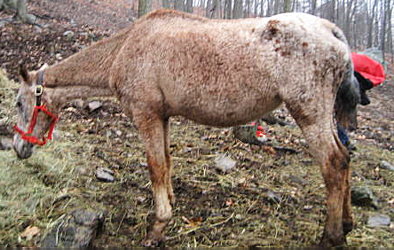 |
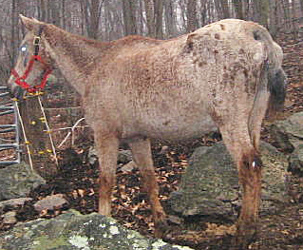 |
Jen was rescued by Michelle Ives of Chestnut Hill Curlies in Connecticut. Not only was she underweight but she was also pregnant. The Vet scored her at a 1.5 on the condition chart.
Reader Comment: Make sure Dental Teeth floating is up to date, minimum of yearly, some horses need more, but they should be at least checked once per year, and if not needed, then good! Jen made better progress once her teeth were addressed.~Michelle of Chestnut Hill Curlies
Too Fat or Obese If he exceeds his optimum condition, your horse may be at risk for founder and other serious health risks. If you are feeding grain, reduce it to 1/2 cup or none at all. You may have to increase the amount of exercise or decrease the quantity of the forage to maintain optimum weight. Good record keeping of past amounts and results makes adjustments much more accurate. The photos below are examples of horses in the Score 5 catagory, very fat, obese.

Reader comment: Horses on pasture or hay only, that don't need grain, will need a vitamin/mineral mix at the very least, because our soils are depleted. Most areas are deficient in magnesium, especially easy keepers (low mag makes them fat), and most of our soils are higher in calcium than mag, and of course alfalfa is. Also, a horse that is jumpy, jittery, spooky also needs magnesium. It can be mixed with, a handful of oats, handful of hay stretcher pellets, handful of alfalfa pellets, etc. ~Michelle of Chestnut Hill Curlies
Feeding Young Curlies
Comment from a Breeder: Many first time horse owners will purchase a weaning, as their first horse, and feeding a weaning and growing horse can be a real challenge. A good worming program is a must, but you must also understand the special needs of a growing horse. Weanlings through age 2 have higher protein requirements than an adult gelding for instance. This need can generally only be met, with feeding grain, some feed alfalfa hay or a vitamin supplement. One of my favorites, for weanlings+ is "Safe Choice".....other mixed grain choices can be used, oats alone, though popular, lack in a balanced diet, and must be supplemented with another product. Read those grain bags, I never feed the maximum, our breed rarely needs it, but start with the minimum, and see how things go. A big hay belly on your youngster usually means, they are overfilling on hay, in an attempt to get their nutritional needs met. Instead of "more" try feeding better....ie...instead of more hay, feed a bit less hay, with a concentrate supplement. Feeding it a trial and error process, each horse has different needs, further complicating the process, but some folks are gifted and has a sense of knowing what works and what does not. If your horses look good all the time, you probably have it right, if you are seeing youngsters that seem to be lacking, they probably are. Take the time and effort to learn, it will pay off in the long run, with a healthy, active horse, that will have a lifetime of good health. ~Creekside Curlies
Summary
ALL of these situations are SO preventable! It is important that a horse owner face the facts and realize that maintaining their horse's body condition is alot of work and takes constant & careful evaluation, but if you aren't willing to do so, then you have no right in owning horses, imo.
Key is getting an education and understanding how to "see" this in their horses. If you are unsure after reading this article, schedule a vet to come and evaluate your horse for you. It is your responsibility & duty to do so as the sole caretaker of these magnificent animals.
NEW! In closing, It is also important to understand when taking on ownership of a horse just what your average costs may be. This will help in deciding ahead of time if owning a horse is for you and if you can afford proper care. Michelle Ives prepared the following detailed costs list which I found extremely benefical.
THE COST OF HORSE OWNERSHIP
First of all, an average 15H, 1100 pound saddle horse in light work should be fed at least 2.5% of their body weight per day in forage, on average. That can be a little less in summer, and a bit more in winter to keep them warm.
Assuming that average 15H 1100 lb. horse eats 27.5 pounds of hay per day. An average 50 lb. bale of Timothy/Orchardgrass hay, which is common in the Northeast, is around $5.50 picked up (add $1.00 or more per bale for delivery, and add $2 or more per bale at the feed store). That equals .11/lb. 27.5 lb. x .11 = $3.03 per day for hay.
Grain averages between $12.00 and $18.00 for a 50 lb. bag. I have priced and found the feeding requirements for some popular brands in my area of Connecticut.
Triple Crown Senior @ $17.90 +. 06 tax = $18.97 / 50 lb = $.38/lb
Feeding rate: 6-10 lb/day = $2.28 - $3.80/day
Triple Crown Lite $ 17.55 + .06 tax = $18.60 / 50 lb = $.37/lb
Feeding rate: 2-4 lb/day = .75 - $1.48/day
Triple Crown Low Starch $17.55 + .06 tax = $18.60 / 50 lb = $.37/lb
Feeding rate: 6-10 lb./day = 2.22 - $3.70/day
Blue Seal Pacer $15.07 _ .06 tax = $15.97 / 50 lb = .32/lb
Feeding rate: 4-15 lb./day = $1.28 - $4.80/day
Blue Seal Charger $14.29 x .06 tax = $15.15 / 50 lb = .30/lb
Feeding rate: 4-15 lb/day = $1.20 - $4.50/day
Blue Seal Trotter $12.00 x .06 tax = $12.74 / 50 lb. = .26/lb
Feeding rate: 5-10 lb/day = $1.30 - $2.60/day.
So, your daily feed for the care of one healthy 1100 lb. horse will average between .75 and $4.80 per day for grain and will be around $3.00 per day for hay. That total is $3.75 to $7.80 per day. Multiply by 30 days per month, and your average cost to feed a healthy 15H horse is a minimum of $112.50 and can easily go as high as $235.00. That cost can increase easily depending on the amount of work your hose is in, as well as its breed. Thoroughbreds, for example, are known to need a much higher amount of feed in relation to their body weight than the average Quarterhorse.
These figures do not include the cost of farrier visits, which average approximately $40 for a pasture trim with no shoes and is necessary every 6 weeks, which calculates to a cost of $30.00 per month. Deworming should be done every other month and you should rotate dewormers with Ivermectin and Strongid at a cost of approximately $5-$10 per dose, which would come out to approiximately $7.00 per month.
Hay = $303.00
Grain = $22.50 - $144
Farrier $30.00
Deworming $7.00
$332.80 to $484.00 per month for one horse
Don't forget yearly vet visits for about $200 ($100 farm call plus vaccinations and Coggins), and any veterinary care for illness or injuries, which averages to about $18.00/month not including emergencies, which you should keep a couple thousand put away in a savings account specifically for equine emergencies. Add in a dental visit at $100 per year if your horse has no tooth or mouth problems, for another $8/month.
We have now brought our cost up to $350 - $500 per month for one average, healthy horse.
Of course, this does not include tack (bridle, bit, reins, saddle, girth, stirrups, saddle pad), supplies (halter, lead, buckets, deicers, salt block), fencing materials, barn or shelter and repairs to each, or any health supplements your horse may need.
Sent to CHC by Michelle Ives. Thanks Michelle!
